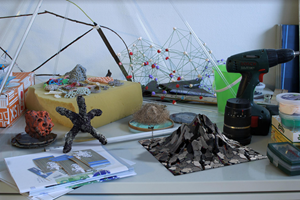
Disentangling archives give us the ability to enter a new era as we disposition between organic and artificial telepathic communication. In this article, the aim is to overcome digital colonization of the human brain by analyzing the 20 years of the Pixelache archive.
ABSTRACT
Disentangling archives give us the ability to enter a new era as we disposition between organic and artificial telepathic communication. In this article, the aim is to overcome digital colonization of the human brain by analyzing the 20 years of the Pixelache archive. The themes emerged from the investigation were: human and non-human relation between artificial and actual physical world, tangible interfaces, consciousness presence in the ‘now’ moment, the body-movement articulation, gesturing including both digital and non-digital interfaces and systems, tangible and haptic interfaces within new technology progress, empathic communication skills awakening emotional aspects of expression and interaction. This article frames Pixelache inside a larger international context and underlines common operational aspects as well as what makes some artist-run institutions so unique. This juxtaposition is instrumental to find out themes that need yet to be investigated, and fields where the activity could expand in future. The future perspective of Pixelache Helsinki festivals and new media, involves the ethical principles in understanding digital and non-digital interconnectedness, and re-establishes the values of aesthetics that the art world is based upon.
Keywords: consciousness, telepathic communication, body movement, ethics and aesthetics, digital and non-digital, physicality and digitality, philosophy, art & science, pixelache, festivals, artist collective.
Table of Contents
1.1. From Transdisciplinary Research to Fully Formed Festival Program
2.1. How We Are Entering a New Era
2.2. A Platform for Emerging Arts Between Organic Thinking and Digital Interfaces
2.3. Pixelache and Other Artist-run Institutions
3.1. Conclusion: Future Perspective
1.1. From Transdisciplinary Research to Fully Formed Festival Program
Knowledge exchange in the building of international festivals strengthens communication and connection as well as enhances different cultural experiences. Pixelache art festivals are beneficial for the art communities in general as they bring together parties for various backgrounds, places, and disciplines. Pixelache Helsinki art festivals have developed from local to worldwide artistic engagements of diverse individuals: artists, scholars, academics, scientists, programmers, and other participants. The meaning of the word pixelache is associated to a feeling of being overwhelmed with the digital and an overdose by digital information – criticism of contemporary time.1
As a trans-disciplinary platform for emerging art, design, research and activism, Pixelache began as a festival of electronic art and subcultures. Since 2022, it has been organizing progressive programs which include seminars, workshops, exhibitions, performances, concerts and club events. Amongst the fields of interest are: experimental interaction and electronics, code-based art and culture, renewable energy production/use, participatory art, open-source cultures, bio arts and art & science culture, alternative economy cultures, politics and economics of media/technology, audiovisual culture, media literacy and ecology, and engaging environmental issues.
The advantage of Pixelache festivals is that they are inclusive of both, digital and non-digital interfaces and systems. The physical actions in real time and space, organic thinking often collectively articulated, are interwoven with virtual reality, using digital tools, programs and techniques, improving skills, while re-questioning the relation towards new technology on creative workshops, art events, projects, nurturing human-nature relations. Addressing various subjects, especially in the last ten years with the idea of adapting to a permanently changing circumstances, some of the themes of the festival have been: D.I.W.O. Do It with Others (2012), Facing North – Facing South (2013), Commoners Unite! (2014), Living Spaces (2015), Interface for Empathy (2016), Local & Decentralized (2017), Breaking the Fifth Wall (biennially from 2019), Burn (2021).
Many themes arose as the archive was sifted through. For example, patterns of Pixelache being perceived as a ‘thinking out of the box’ festival because it approaches digital and non-digital interfaces. It gathers creative individuals in uplifting activities going beyond expected results. It challenges mainstream conventions, invites everyone to participate, finds common solutions dealing with contemporary issues of global warming, examines humans and non-humans, presents environmental standards including a variety of tools or, analyzing the economy for social sustainability and efficiency in regards to the money lab workshops 2. It tracks current politics, rising collective consciousness in preserving nature as well as in new technology developments, aiming to evolve interaction and interconnectedness within humanity.
As the investigation continued many questions came to surface. Could empathy be a key to reconnect us with our ecosystem and ourselves? The theme of 'Interfaces for Empathy' explores the promise of possible societal shift through macro-level direct experiences, and the perspective of interconnectedness of all living systems, visible and invisible ecosystems and energies. Technology serves as a mediator in accomplishing aspects of communication, of all and for all, challenging the contemporary turmoil in shaping social life.
2.1. How We Are Entering a New Era
Pixelache festival presents artistic projects and approaches of understanding technology, as opposed to not being a mere consumer 3, but rather a creative individual using new technology for subjective development, enhancing the community in general. How can society overcome the contemporary circumstances of the pandemic, the economic turmoil and war 4, while paradoxically technological progress continues? How can we advance our way of life, without producing more waste that is left behind? Digitalization is shaping the modern way of life, it is especially obvious in big cities. The examples of the artworks, workshops, and projects presented at Pixelache in the last ten years are re-calling to relations between human behavior, environment, architecture, technology and communication, and associations with the diversity of living systems.
Golan Levin’s interactive artwork with Zachary Lieberman, Reface 2007 (presented in Kiasma Mediatheque 2010, not organized by Pixelache), is the portrait sequencer which composes endless combinations of the visitors faces, by using face-tracking techniques, which allow automatic alignment and segmentation of the participants' faces. The artistic creation in this innovative interactive play with participants’ eye blinking, results as a kinetic "generative group portrait". It blends appearance and identity, the personalities and the genetic traits of visitors on site.
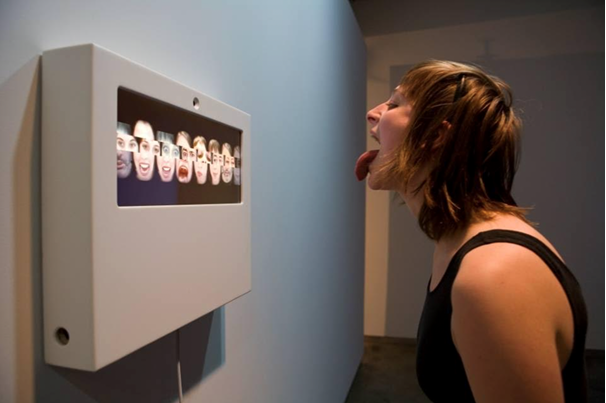 Golan Levin and Zachary Lieberman, Reface 2007. Image courtesy Pixelache and the artist
Golan Levin and Zachary Lieberman, Reface 2007. Image courtesy Pixelache and the artist
The work of Alessandro Ludovico and Paolo Cirio, Face to Facebook (presented at Map me if you will seminar at Pixelache 2011) exemplifies a critical provocative review of virtual profiles and digitized identities. It is based on stealing one million Facebook profiles, filtering them with face-recognition software, while posting them on a custom-made dating website. The work evokes strong reactions from people's comments on Lovely–faces.com and Face–to–Facebook.com. The official Facebook’s reaction resulted as legal action which prevented the work from actualizing. 5
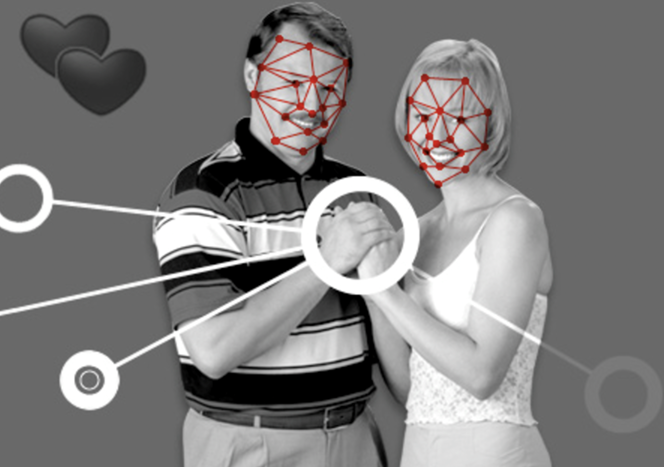 Alessandro Ludovico and Paolo Cirio, Face to Facebook, Pixelache 2011. Image courtesy
Alessandro Ludovico and Paolo Cirio, Face to Facebook, Pixelache 2011. Image courtesy
Pixelache Helsinki and the artist
If interactive actions bring to life an artwork-event that awakens participatory behavior (Kluszczynski, 2010), a good example of interaction is the Rambler by Ricardo O’Nascimento (on Pixelache web archive). It takes digital data of participant’s walk through the city, with embedded sensors in the shoes, and it results in a real-time posting of the participants' steps, on Twitter. The physicality of the participants’ behavior, the steps in the physical space are being merged with digital data. They are enabled by wearable-technology designed shoes, which enable online mapping of participants’ step patterns. The Internet connects people from different parts of the world beyond cultural differences, religion or any other differentiation, allowing interpersonal immediate communication. At the same time, digital techniques used in these generative interactive artworks, predicted how new technology can manipulate social structures, for example in modern China with technocracy. 6
Projects like Twin City of Talsinki / Hellinn, Between Borders, Visions and Reality, (Pixelache 2013), raise viewpoints, which emphasize strong interaction between perspectives of conflicting narratives that derive from passengers searching for new opportunities residing in these connecting cities, outlook and urban planning. Another relational aspect between human memory and the environment surrounds the Pixelversity / Ruins project (Pixelache 2014), which occurs as a series of ruin-value theoretical walks in contemporary Finnish cities, such as Helsinki and Pori. It shows the process of re-thinking the future in relation to architecture. What kind of ruins will the modern urban construction leave behind? The value of the ruins adds value also to modern architecture, and invites participants from different fields (science, art, religion) to participate in guided tours. The process is visualized by merging older sites and actual and existing ruins together. By doing so, it brings into relation the environment, memory and the temporality of nature.
Various examples of circular objects containing built structures and open space from the Neolithic to the present, are related to the basic geometrical form, the circle; this becomes evident in the article titled Circle in Space, Space in Circle, the future perspective of architecture. The proposal is for the future urban constructions to enable organic, communication aspects, and more intuitive interconnection between human, nature and its surroundings. It draws a parallel which refers to ancient civilizations, Maya or Inka living spaces in South America, or tribe houses in Africa, as well as churches, mosques, or modern building expressing a technologically developed era, that is the Apple’s new campus is also built in the shape of a circle (Jović, Čučaković, Grbić, 2021).
2.2. A Platform for Emerging Arts Between Organic Thinking and Digital Interfaces
Pixelache festival is inclusive to both, digital and non-digital interfaces and systems, which validates the necessity of establishing a balancing relation between physicality and digitality of contemporary time. The USB Dead Drop workshop (Pixelache 2015) by artist and philosopher Erno-Erik Raitanen, is an example of a point of disconnecting and, at the same time, connecting an analog actual physical materialistic world with digital a virtual reality store. The placement of USB Dead Drop in urban public space is made accessible to anybody and represents the solidness of the intangible-invisible digital memory, placed in stationary material of a wall, in a public space.
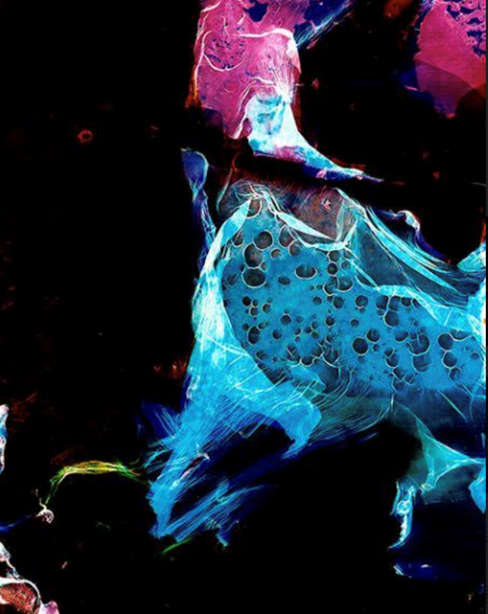 Erno-Erik Raitanen, Bacteriograms, 2008-2010. Image courtesy Pixelache Helsinki and the
Erno-Erik Raitanen, Bacteriograms, 2008-2010. Image courtesy Pixelache Helsinki and the
artist
On another note, the educational features of the festival are significant in enhancing programming skills. The workshops at Pixelversity / Av Culture (2014) titled Creative Coding for Live Audio Visuals, is a learning process of understanding how works are being created in a form of audiovisual performances. Raspberry Pi + Pure Data, acknowledges Pure Data visual programming language, and relies on the platform of Raspberry Pi. It creates live-sampling patches, 7 which are controlled and manipulated by mouse, keyboard, and gamepad. Raspberry Pi + open Framework workshop presents C++ creative coding that runs on different computers: Mac, PC and Linux as well as on Raspberry Pi as a tool that is easy to travel with due to its size despite how many visual synthesizers are embedded.
Earth Hour, presented as part of the Urban Projection Lab (Pixelache 2010), is an artwork by Miska Knapek. A prototype called Energy Pulse, visualizing the total energy consumption amount in the Helsinki city area, went online the same day as the prototype of the interactive sculpture Power Flower and Helsingin Energia. Again it is about publishing a new, real-time, energy meter online.
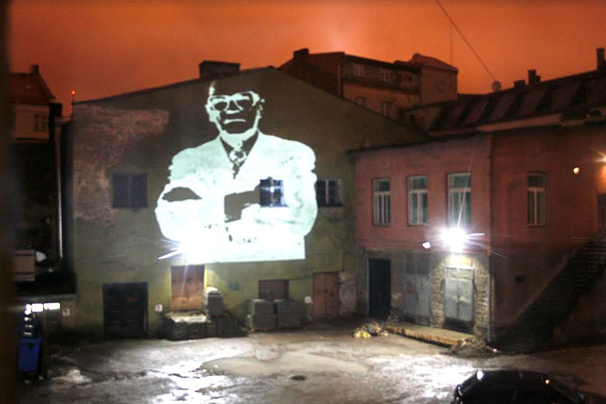 Miska Knapek, The Project Earth Hour, Urban Projection, Pixelache 2010. Image courtesy
Miska Knapek, The Project Earth Hour, Urban Projection, Pixelache 2010. Image courtesy
Pixelache Helsinki and the artist
Human and non-human interfaces presented at the workshop by Lithuanian artist Mindaugas Gapševičius (Pixelache 2015), experiment with the space of living and nonliving, and underline organic notion of sensing the reality. At the seminar Art and Technoscience (Pixelache 2010), Roy Ascott among other participants, was part of the discussion that went on ethical discourse in art practices. Technologies of encounter consider human and non-human relations, implies as well traditional understanding of agency, community, questions political implications, manipulation, objectification, and abuse of non-human.
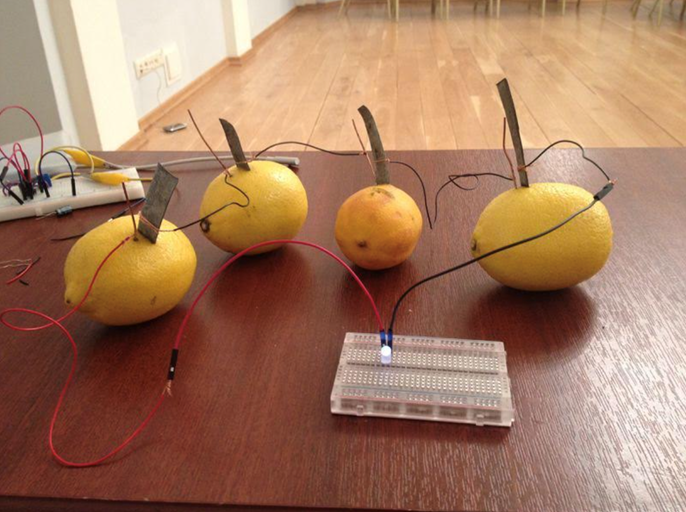 Mindaugas Gapševičius, Human and non-human interfaces workshop, Pixelache 2015. Image
Mindaugas Gapševičius, Human and non-human interfaces workshop, Pixelache 2015. Image
courtesy Pixelache Helsinki and the artist
Telepathic communication interconnects humans with other spaces and living systems beyond the expected. Intuition is an immediate understanding that elevates human spirit and consciousness overcoming toxicities and waste production which marks the contemporary time of the global modern cities. In the present day the conception of the Anthropocene has emerged as the reality which unexpectedly brings worlds together with diverse shapes, as well as an amorphic coexistence. 8 If communication strengthens connections and comprehension, Alpaca Oracle (Pixelache 2015) by Mari Keski-Korsu, the telepathic project aims to ask help and advice for humankind from other animals. It gives the possibility of expanding human understanding in the present state, inter-species communication or telepathy, and the future prospects of life on Earth. The project introduced the biggest alpaca herds in Finland to its participants. Practicing telepathic skills, for example enhancing empathic connection to other species, is representing deepening connection to the ecosystem we live in.
Human relation to body is essential in developing human relation to nature, physicality, using diverse senses, proprioception or articulation of body movement and its gesturing, consciousness presence in the now moment (Fićović, 2016). The organic-body tool, using proprioception sense, can ground the virtual reality, and occupy the mind, influencing on cleansing the digital – pollution or, digital social toxicities, that in fact represents a digital colonization of human brain today. 9
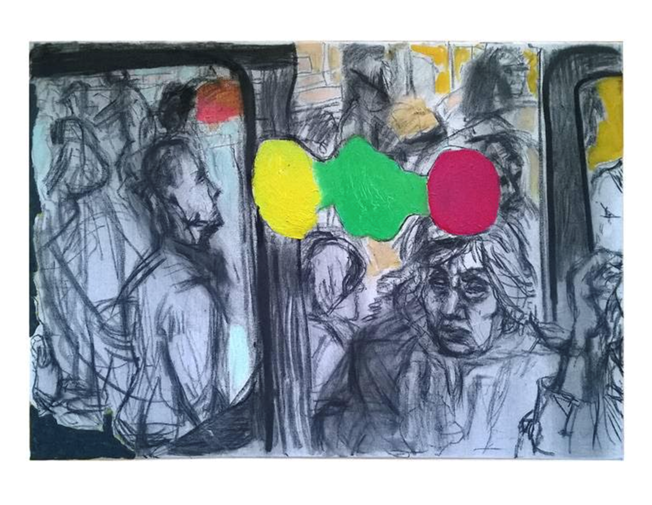
Isidora Ficovic, Inside of the public bus, 2012. Image courtesy the artist
Another example of the physicality of interface activation of human bodies in the public space, the collective action with ropes, creating a net out of rope as the metaphor of digital social networking, was seen at the workshop Invisible city (Kiasma seminar room, Pixelache 2010). The importance of growing plants, especially in urban areas, a hallmark of The Making of Windowfarms project (Pixelache 2010-11), shows growing plants in the huge Kiasma takaikkuna illuminated with LEDs. The organic way of thinking can be developed by humans nurturing nature. The Trashlab theme, which explores experimental art-design-technology practice between hacker and maker cultures, focuses on re/up-cycling an increased available new fabrication. Also, Trashlab project (Pixelache 2014) coordinated by Päivi Raivio, deals with material and electronic waste in contemporary society. It has objectives in building community, including artists, hackers, designers, activists, and makers. Loving the trash by structuring urban life’s ecosystem, seeing it as material for creative solutions in organizing the urban environment, turns out to be an emotional attachment to trash.
Returning to human-non-human-interfaces, the newest project and workshop led by Lithuanian artist Mindaugas Gapševičius (Burn, Pixelache 2021), experiments with the space between the living and nonliving. The project considers the space inhabited and shared between organisms and machines. Electronic interfaces are built in order to bridge multicellular organisms like a plant or human body with a digital machine. Where technologies and organisms merge, it shows a state which is described by Katherine Hayles as a posthuman (Hayles,1999) in the project Humans and other organisms experiments with the space between the living and nonliving.
Greta Thunberg's book No one is too small to make a difference, brought by I am the Messenger (Pixelache 2021), expresses the feeling of anger addressed in a clear message about the moment – when things are falling apart it means that the time for change is possible. If art is about the experience, human feelings, the human sensibility can be transferred via manual work. In the history of art, the special values of manual work are appreciated in for example, painting and drawing. The tactility, haptic interfaces in electronic materials and new technology, tools of a new media, is what future transdisciplinary platforms should be focused on, since body movement and gesturing, and hand gestures in particular awake consciousness in the now moment articulating different human senses.
If human survival is endangered by overexploitation of the planet's resources, what is ethical in current technology, scientific innovation, and new technological developments? Returning to the ethical principles, it can be what makes a difference in the paradoxes of globalization, which artist Hito Steyerl 10 exposes in the relation between political economies, visual culture, and the status of art production (Steyerl, 2017).
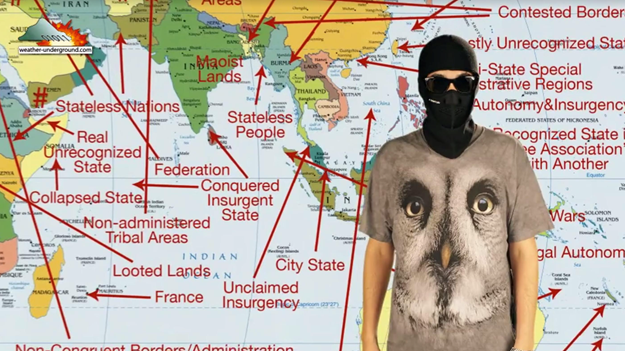 Hito Steyerl, Liquidity Inc., 2014. Image courtesy the artist, Andrew Kreps Gallery, New York, and Esther Schipper, Berlin/Paris/Seoul © Hito Steyerl / VG Bild-Kunst, Bonn 2022
Hito Steyerl, Liquidity Inc., 2014. Image courtesy the artist, Andrew Kreps Gallery, New York, and Esther Schipper, Berlin/Paris/Seoul © Hito Steyerl / VG Bild-Kunst, Bonn 2022
Awakening consciousness as well as developing collective consciousness, from telecommunication to telepathic interaction, provides time for humans to deal with the philosophical aspects, alongside the science advancing and the technological applications. If Artificial Intelligence (AI) replaces labor, humans can interconnect on the level of consciousness and technology of time 11. As the ancient Greek philosophers discussed aesthetics and ethics, the notion of New Aesthetic (Bridle, 2013) in algorithmic transdisciplinary learning platforms of the 21st century is vital for the philosophy to understand the paradoxes of globalization, that Steyerl refers to. The ethics and the aesthetics challenge various aspects of contemporary art strategies, and the notion of sublime, food for the soul. It is in this vein that Jadranka Skorin-Kapov in her book The Intertwining of Aesthetics and Ethics (2016), gives more weight to Kant's notion of the sublime as the major foundation for ethics and aesthetics. She claims that sublimity provides the most proper aesthetic experience for both art and nature. As the sublime points to something beyond our physical existence, it grounds ethics and aesthetics in the same realm of metaphysics.
The future is now, or, there is no future, (Burn Ecocide, Pixelache 2021) references global warming, ice melting, endangered food sources of the Antarctic krill, which are the main food sources for the Humpback whales. Nomadic Seeds: Desert Strawberries and PhosFATE by artists Mohamed Sleiman Labat and Pekka Niskanen, presented at the Baltic Sea screening & discussion, exposes the notion of garden, essential for local as well as global communities, not just representing the source of edible food, but also the activation of multisensory experiences, that are nevertheless a part of artistic immersive creations.
To challenge contemporary art and science, inevitable philosophical aspects of ethics and aesthetics, a transdisciplinary coexistence is questioning the merging of human and machine and the idea of cybernetics (Wiener, 1948). It's necessary now more than ever to underline the notion of organic thinking that puts humans out of the center, which is opposite to the central position during the Renaissance. Today's focus could be maybe more about metaphysics of inner being, relations to universal laws in sciences. Being grounded in the moment, where music, nature and culture coexist in collective consciousness, is what body movement encourages. The body movement of the eternal now expressed by the circular form (The Circular Movement of Dot, 2020) 12, conveys the intention to harmonize the notions of destruction and construction regarding global urban transformations, another digital colonization of the human brain. The presence in the moment could be considered a flow of energy of the ubiquity-human instead of the anticipation of the post-human. Curiosity explored on an emotional map, where all of these possibilities of transdisciplinarity in the field of art and science occur, accompanies contemporary strategies for an artist’s inner expressions, and contingent models of artistic production.
2.3. Pixelache and Other Artist-run Institutions
It is necessary to put the existence of Pixelache inside a larger context, within the wider landscape of international organizations. It is useful to understand what are the common grounds for many grass-root initiatives, and what makes some of them so specific and unique. The contextualisation of Pixelache operational modalities is also instrumental to foresee the next developments, to point out directions that still need to be investigated, and where the activity could expand in future.
The infrastructure for art strategies and art production is closely related to the economy, politics, art market, coordinated by the art world, private art institutions, art galleries, collectors, non-profit institutions including museums, associations, and art centers. The logistics until the artwork reaches the audience, or art markets, involves three stages: creation, production and distribution. The Art World internationally adopts a convention on the value of an artwork, which then receives a certain price based on the art market. The Art World consists of the State (that invests into art field institutions), museums, collectors, sponsors, art galleries and curators, biennials as well as external factors, banks, art managers, and designers. Within the Art World, curators represent the gatekeepers, selecting the valued art works for exhibitions and shows, according to certain consensus.
Piknik Frequency ry is a registered non-profit association 13, (working name Pixelache), its members are the supporting source for festival realizations, from the beginning of 2002 in Helsinki with annual activities, with biennial character from 2019. People's interest for art, going to galleries, visiting other cultural institutions, depends on the communicative aspect and networking within the art world or, it relies on media promotion. Pixelache is well covered by media press with a list of supporters, actively engaged in cultural projects and collaborations on a year-round basis. 14
Having a similar artistic field of interests as Pixelache, Ars Electronica in Linz, Austria organizes the Ars Electronica festival that is one of the main festivals in the world for electronics and new media. Happening each year in September with exhibitions setup on a few locations in the city, it presents interdisciplinary approaches, art and science, and new technology achievements. The festival welcomed known names who also participated in Pixelache such as Roy Ascott, and Ricardo O’Nascimento. Unlike Pixelache which has a lot of projects based on the process of diverse members, Ars Electronica festival is the platform for presenting already produced artworks and projects installed in exhibition venues, with talks, presentations, discussions, and Prix Ars Electronica Award. Hiroshi Ishii (MIT), regular guest of Ars Electronica festival (in 2016 the festivals title Radical Atoms is named upon Hiroshi Ishii’s project Tangible Bits & Radical Atoms) 15, introduces interface of HCI, as the time and interactivity (Dix, Finlay, Abowd, Beale, 2005) that deal with movement, body, hand gesturing, and tactility. The issue about the importance of tactility in the art world, questions the aesthetic in art and consensuses, state of mind and feelings. Concerning the everlasting question of what is art, Roy Ascott presented at Ars Electronica 2014 16 the idea of having mobile phones integrated into the human body in 2050, re-calling the notion of merging human and machine presented in Norbert Wiener’s cybernetics. Inside a technocratic society, human behavior becomes shaped by social scoring with mobile apps (system of control and punishment), and during pandemic and vaccination campaigns, contemporary politics became a bio art demonstration of social engineering. It’s what Mignolo describes as a change of epoch (Mignolo, 2020).
Resonate festival lasted for only a few years in Belgrade, Serbia. It consisted of intensive talks and lectures, knowledge sharing, presentations, educational activities, involving international participants. It was about setting new standards in the arts industry by creating new platforms for networking and sharing information, and for debating on the position of technology in art and culture. The Resonate festival in UK City of Culture Coventry, brought a twelve-month inspiring and interactive events program of great ideas, curiosity and creativity (for all ages in Coventry and Warwickshire). Similar to Pixelache, it encompasses areas ranging from software engineering to visual arts theory, bridging culturally separated segments of the artistic and intellectual scene through a comprehensive, multidisciplinary approach. Another example is a short-term international platform conference named CGA Belgrade, presenting educational workshops and lectures on electronics and new media, where people can meet, exchange contacts, and with the pandemic crises (covid 19) it switched to online platform meetings.
The Pixelache festival’s uniqueness is ethical interconnection, doing well for the community, finding solutions in main topics of contemporary problems related to economy building circumstances that evolve society, economic sustainability, and creating its own local currency (Suomenlinna Money Lab workshop). 17
The economic global crises which started in 2008, shifted the art market to China, auction houses like Sotheby’s and others, moved to Asia. International galleries, network of art founders are currently present in 798 districts in Beijing. 18
Rising collective consciousness on Pixelache projects, such as intellectual collectivity, relates somehow to the Apartment Project Berlin, Germany, the collective thinking-based artist-run initiative. For example, the quality of production, the process of communication which leads to collectively building art projects, comes across various topics. Some of the projects dealing with the problems of migrants and refugees in Europe, are oriented to understanding a reality through communication, talks, and the artistic projects are entangled with several countries. 19
Pixelache, was initially oriented to a local Helsinki small-size festival, and it developed through the years into an international community, having several branches in different countries. 20 Similarly to Pixelache, Instanbul SAHA initiative is a good example of infrastructure, which supports the artistic productions, sustainability fund. SAHA Association was founded to support artists, curators and writers working in visual arts from Turkey in improving their production and development environments, and to enhance their interactions with international art institutions and networks. 21
Returning to the notion between digitality and physicality of Pixelache festivals (discussed in the first part of the paper), inclusion of both digital and non-digital interfaces and systems, the process of creating activities and projects, is a privilege of Pixelache. The aesthetic as well as ethic, the philosophy and culture of ancient Greeks (Jones, 2019), represent a challenge for science and for the future perspective of technology and new media. It encourages the significance of spirituality in contemporary global society, as a key to overcoming global crises and turmoil (economy, pandemic, war), all consequences of the politics of ego-power game.
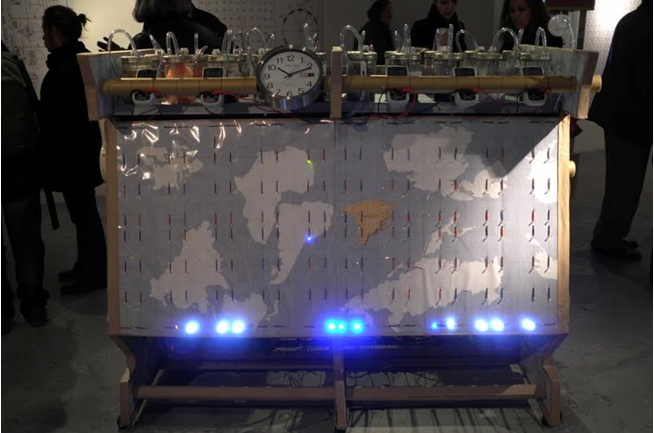 Jean Katambayi Mukendi, Ecoson, 2011 © Collection Fondation Blachère, Pixelache 2011.
Jean Katambayi Mukendi, Ecoson, 2011 © Collection Fondation Blachère, Pixelache 2011.
Image courtesy Pixelache Helsinki and the artist
Another kind of artist-run space, Alzueta Gallery, a contemporary art gallery in the center of Barcelona, is located in an old textile factory. The gallery stands for modernity, radicalism, transformation, ideas and the politics of change, bringing contemporary art into the calm retreat of the Catalan countryside, with antique furniture, creating a situation where people can calmly discover new relations between art and its settings. In this gallery, the production of art is more oriented towards visual language, the value of colors, compositions, rhythm, lines, and surfaces, presented with the medium of drawings and painting, and then displayed at international art fairs, as one of the most wanted and sellable media.
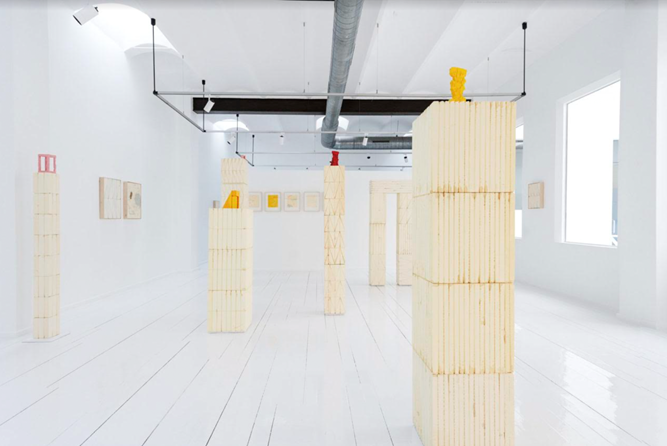 Bruno Ollé, Under The Skin at Azuelta Gallery, 2021. Image courtesy Azuelta Gallery and the artist
Bruno Ollé, Under The Skin at Azuelta Gallery, 2021. Image courtesy Azuelta Gallery and the artist
Nafasi Art Space in Dar es Salaam, compared to Pixelache, is unquestionably a way of making art that is built upon the idea of working together. This contemporary art center founded by a small group of Tanzanian artists, presents special events that look at issues of post-colonialism and African identity and society through the lens of contemporary art practices. As one of the foremost multidisciplinary creative hubs in Africa, Nafasi Art Space welcomes interdisciplinary public events such as music festivals, concerts, film screenings, art talks, workshops, and dance performances, providing a meeting point for intensive dialogue and exchange between artists and the public.
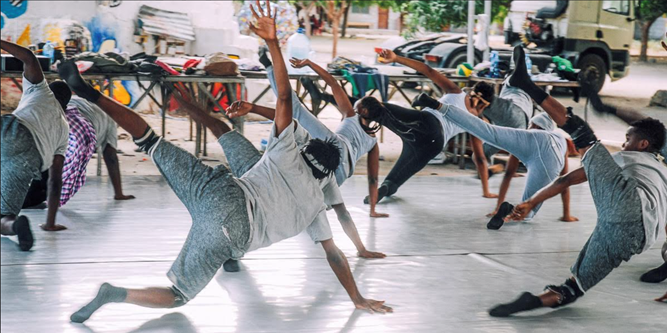 MuDa Contemporary dance workshop at Nafasi Art Space, 2019. Image courtesy MuDa Africa
MuDa Contemporary dance workshop at Nafasi Art Space, 2019. Image courtesy MuDa Africa
Modern ways of financing the global society shift to functioning online, bringing the visibility of artworks via Instagram or other social networks on the Internet, that reaches a huge audience. Independence is the privilege of the future perspective in various parts of social activities and in the art world. Still, with new media technology developments, the question Was ist Kunst (what is art) remains a contemporary quest.
3.1. Conclusion: Future Perspective
Human brain is not working digitally. Therefore in relation to digital, it is important to keep the presence of body movement underlining physicality, for example in the framework of Pixelache the walking guide-tour with Pixelversity/Ruins project. Future perspective on Pixelache paying attention to music, nature, culture, body movements, would be the introduction to a diversity of dance practices, rhythms and cultures. The spiritual aspect of dance, rituals of ancient cultures or traditional ones, folklore, waltz, dancing rhythms of Africa, explores movement of human body, sound, aesthetic and rhythm as spirit’s emanation. The Latin phrase says mens sana in corpore sano (a healthy mind in a healthy body). Or for example, Aristotle’s strolls in The School of Athens 22, shows a more efficient way of learning by walking. Harmonizing body-mind coordination is efficient for acquiring knowledge. If we consider digitalization and educational system, interfaces are still limited to a sitting position and limited typing gestures on keyboards or mobile phones (see the photo documentation of programming, coding, workshop on Pixelversity/ AV Culture, mentioned in the first part of the paper, obviously shows that the HCI didn’t change from the last century).
Communicational aspects are changed, since digitalization influences human brain by fragmenting the content of the memory, therefore the focus on reading is deranged. 23 Bringing back the focus of the brain, calming the state of mind (Buddha consciousness), 24 could be a challenge for interactive events, and meditative aspects. Aesthetics, quality and values make a difference in experimental electronic arts. The new media scientifically approaches the creation with learning processes, cognitive skills are rationalized with engagements based on problem solving, programming skills advance with future perspectives, collective mind-body articulates the practices through body movement and gesturing. 25
Are we going that fast with contemporary digital navigation that we include mobile phones for every banal action, missing in that way the physicality of the real, like smell, taste, touch, diverse senses that evoke feelings, happiness of summertime? Art is based upon expression of emotions into aesthetics. Through centuries, these questions penetrate into philosophy, ethics and aesthetic, and this is an inevitable contemporary challenge for new media technology development, as well as for the future perspective of Pixelache. Establishing a dialogue based on a word-based communication (language, culture, writings – the ecosystems of linguistics), intuitively being present in the moment, while telepathically interconnected with ecosystem and other living systems, the channels of nature (telepathic communication, still part of Aboriginal culture in Australia). 26
How we are entering a new era, talking about modern cities, digital and non-digital interfaces, relation human non-human, interconnection of living systems, smart cities or wise villages, the efficient economy, NFT virtual objects, overcoming the pandemic, communicational aspect of online meetings, free of charge, time efficiency, without hitting the wall on energy consuming? In shaping the ecosystems and urban areas, if observing these aspects from the future perspective, AI and online function of society, the choice between smart city and wise village is essential, awakening consciousness and all human senses. Manual hand gesture is important in sensing the real – it can be experienced in human and non-human body-mind coordination, and in Buddhist contemplation 27 as a state of mind – offers a balance towards the digital. The balance between the organic, physical, analog interfaces and virtual reality are what Pixelache encourages from the beginning, a future perspective of ubiquitous human, flexible and fluent, like water.
Feature Image: Naab+Teeri, the process to realise an iteration of Thinking of Invertebrates, presented at Pixelache Helsinki Festival, Local & Decentralised, in 2017. Image courtesy the artist and Pixelache Helsinki.
NOTES
See Hiroshii Ishii, Tangible Bits & Radical Atoms : https://vimeo.com/389799707 access 02.04.2022
https://ars.electronica.art/aeblog/en/2014/10/01/roy-ascott-wir-sollten-unserem-herzen-folgen/access 15.04.2022
(https://aboriginalincursions.com.au/the-dreaming/aboriginal-ceremony-explained)
(https://www.fgsitc.org/the-four-contemplations/)
REFERENCES
Mignolo, Walter D. (2020), The Logic of the In-Visible: Decolonial Reflection on the Change of Epoch, First published October 13, https://doi.org/10.1177/0263276420957741
Bridle, James (2013), The New Aesthetic and its Politics. Booktwo.org, http://booktwo.org/ notebook/new-aesthetic-politics/
Steyerl, Hito (2017), Duty Free Art: Art in the Age of Planetary Civil War, Hardcover, November 21.
Jones, Nathaniel B. (2019), Painting, Ethics, and Aesthetics in Rome, (Greek Culture in the Roman World), Cambridge University Press, March 14
Wiener, Norbert (1948), Cybernetics or Control and Communication in the Animal and The Machine, The Technology Press, Cambridge, Mass.
Ishii Hiroshi, Dávid Lakatos, Leonardo Bonanni, and Jean-Baptiste Labrune (2012), Radical Atoms: Beyond Tangible Bits, toward Transformable Materials, Interactions 19 (1): 38–51
Kluszczynski, Ryszard W. (2010), Strategies of interactive art, Department of Media and Audiovisual Culture, University of Lodz, Poland, Journal of AESTHETICS & CULTURE Vol. 2
Dix Alan, Finlay Janet, Abowd Gregory D., Beale Russell (2005), Human-Computer Interaction, February 13
Jović Biljana S., Čučaković Aleksandar A., Grbić Mihailo N. (2021), Circle in Space – Space in Circle: A Study of Ratio between Open Space and Built-Up Area in Historical Circular Objects, Sustainability 13, No. 9, https://doi.org/10.3390/su13094662 (accessed on 15 March 2022)
Fićović, Isidora (2016), Interactivity in drawing/writing gesture, from traditional tools to new media devices, AV Akademikerverlag
Skorin-Kapov, Jadranka (2016), The Intertwining of Aesthetics and Ethics: Exceeding of Expectations, Ecstasy, Sublimity Hardcover, April 21
WEBOGRAPHY
Reface 2007 (presented at Kiasma Mediatheque 2010, not organized by Pixelache)
Pixelache | Golan Levin exhibition & Window Farm in Kiasma (accessed on 12 March 2022).
Alessandro Ludovico and Paolo Cirio Face to Facebook (presented at “Map me if you will” seminar, Pixelache 2011) Pixelache | Map Me If You Will seminar (accessed on 12 March 2022).
Twin City of Talsinki/Hellinn, Between Borders, Visions and Reality (Pixelache 2013)
https://pixelache.ac/events/twin-city-of-talsinki-hellinn-between-borders-visions-and-reality (accessed on 13 March 2022).
The USB Dead Drop workshop by artist and philosopher Erno-Erik Raitanen (Pixelache 2015)
https://livingspaces.pixelache.ac/events/usb-dead-drops-workshop (accessed on 15 March 2022).
The Trashlab project (Pixelache 2014)
https://pixelache.ac/events/trashlab-at-kaupunkiverstas-january (accessed on 17 March 2022).
I am the Messenger (Pixelache 2021) https://burn.pixelache.ac/events/i-am-the-messenger (accessed on 20 March 2022).
Burn Ecocide, Pixelache 2021, https://burn.pixelache.ac/events/burnecocide (accessed on 22 March 2022).
Nomadic Seeds: Desert Strawberries and PhosFATE in the Baltic Sea, screening & discussion
https://burn.pixelache.ac/events/nomadic-seeds-desert-strawberries-and-phosfate-in-the-baltic-sea-screening-discussion (accessed on 25 March2022).
Ars Electronica in Linz, https://ars.electronica.art/news/en (accessed on 28 March 2022).
Nafasi Art Space, Dar es Salaam (Tanzania) https://hamburg-daressalaam.de/nafasi-art-space/ (accessed on 10 April 2022).
Resonate UK, https://www.resonatefestival.co.uk/ (accessed on 21 April 2022).
CGA Belgrade, https://cgabelgrade.com/ (accessed on 21 April 2022).
Istanbul SAHA initiative, https://www.saha.org.tr/en (accessed on 22 April 2022).
Alzueta Gallery, Barcelona, https://magazine.artland.com/5-alternative-project-spaces-across-europe/ (accessed on 23 April 2022).
The Apartment Project in Berlin, http://berlin.apartmentproject.org/ (accessed on 7 May 2022).
Meet the Media Guru: Hiroshi Ishii talks about future ways of living and working, https://wow-webmagazine.com/meet-the-media-guru-hiroshi-ishii-talks-about-future-ways-of-living-and-working (accessed on 10 May 2022).
(Editors Egle Oddo and Arlene Tucker, Helsinki, June-November, 2022)

ArtDependence Magazine is an international magazine covering all spheres of contemporary art, as well as modern and classical art.
ArtDependence features the latest art news, highlighting interviews with today’s most influential artists, galleries, curators, collectors, fair directors and individuals at the axis of the arts.
The magazine also covers series of articles and reviews on critical art events, new publications and other foremost happenings in the art world.
If you would like to submit events or editorial content to ArtDependence Magazine, please feel free to reach the magazine via the contact page.